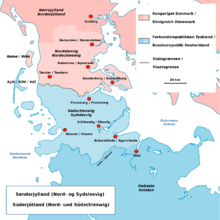Southern Jutland


Southern Jutland (Template:Lang-da) is the name for the region south of the Kongeå in Jutland, Denmark and north of the Eider (river) in Schleswig-Holstein, Germany. The region north of the Kongeå is called Template:Lang-da). Both territories had their own ting assemblies in the Middle Ages (in Viborg and Urnehoved). Southern Jutland is mentioned for the first time in the Knýtlinga saga.
In the 13th century South Jutland became a duchy. The first duke was Canute Lavard (Knud Lavard). In the late 14th century it took the name of the Duchy of Schleswig. The duchy was named after the city of Schleswig (Slesvig). The dukes of Schleswig also became kings of Denmark.
With the demise of the Holy Roman Empire in the 19th century, the term "Sønderjylland" was revived by Denmark and became the subject of a naming dispute between Danes and Germans (the latter continuing the centuries-old "Schleswig") - part of the struggle over possession of the territory itself, which came to war in 1848 and again in 1864.
Following the Schleswig Plebiscites in 1920, South Jutland was divided into Northern and Southern Schleswig. Northern Schleswig was also known as South Jutland County (1970–2006) and is now part of the Region of Southern Denmark. Southern Schleswig is a part of the German federal state Schleswig-Holstein.
Both parts cooperate today as a Euroregion called Sønderjylland–Schleswig, which covers most of Southern Jutland.
